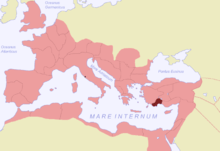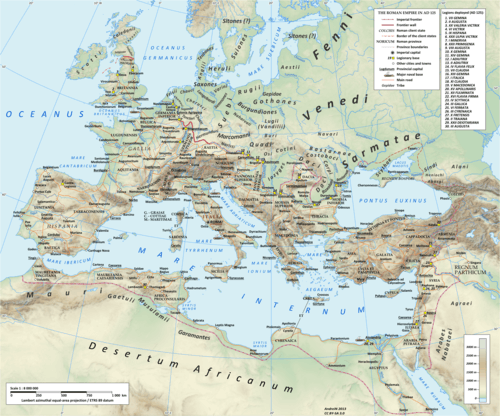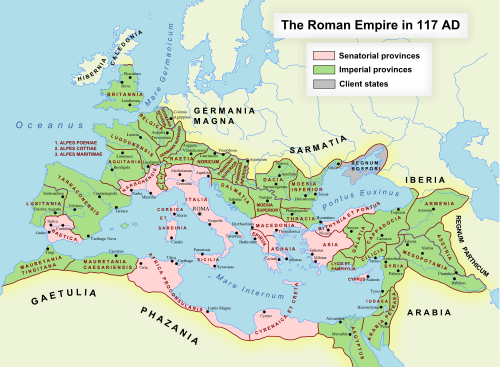Lycia et Pamphylia
Lycia et Pamphylia was the name of a province of the Roman empire, located in southern Anatolia. It was created by the emperor Vespasian (reigned AD 69- 79), who merged Lycia and Pamphylia into a single administrative unit.[1][2] In 43 AD, the emperor Claudius had annexed Lycia.[3][4] Pamphylia had been a part of the province of Galatia.
| Provincia Lycia et Pamphylia ἐπαρχία Λυκίας και Παμφυλίας | |
|---|---|
| Province of the Roman Empire | |
| 74–325 | |
 | |
| Capital | Attalia |
| Historical era | Antiquity |
• Established | 74 |
• Disestablished | 325 |
| Today part of | |


The borders drawn by Vespasian ran west of the River Indus (which flowed from its upper valley in Caria) from the Pisidian plateau up to Lake Ascanius (Burdur Gölü), to the south of Apamea. In the north and east it formed a line which followed the shores of the lakes Limna (Hoyran Gölü) and Caralis (Beyşehir Gölü), turned south towards the Gulf of Adalla (mare Pamphylium) and followed the Taurus Mountains (Toros Dağları) for some ten miles towards east up to Isauria. It then followed Cilicia Trachea to reach the sea to the west of Iotape. The borders were dawn taking into account geographical and economic factors. The whole of the basins of the rivers Xanthus, Cestrus (Ak Su) and Eurymedon (Köprü Irmak) were included. The main cities were at the mouth of the latter two rivers. In Pisidia and in Pamphylia they were in part followed by the few roads into the interior of Anatolia. The most important one was the road from Attalea (Antalya) to Apamea. In Lycia the road from Patara towards Laodicea on the Lycus followed the coast. Important cities were Side, Ptolemais, Gagae and Myra on the coast, Seleucia, inland and Cremna, Colbhasa and Comama, on the Pisidian Plateau, where Augustus had founded Roman colonies (settlements). On the Milyas plateau there were Oenoanda, Tlos, Nisa, Podalia, Termessus, and Trebenna. Other important cities in Lycia include Pednelissus, Ariassus, and Sagalassus; along the Eurymedon, Aspendus and Perge, which had a sanctuary of Artemis. The most important city in the region was Patara, at the mouth of the Xanthus.
Under the administrative reforms of emperor Diocletian (reigned AD 284-305), who doubled the number of Roman provinces by reducing their size, Lycia et Pamphylia was split into two separate provinces. The provinces were grouped into twelve dioceses which were under the four Praetorian prefectures of the empire. Lycia and Pamphylia were under of Diocese of Asia (Dioecesis Asiana), of the Praetorian Prefecture of Oriens (the East).
Governors
(List based on Rémy Bernard, Les carrières sénatoriales dans les provinces romaines d'Anatolie au Haut-Empire (31 av. J.-C. - 284 ap. J.-C.) (Istanbul: Institut Français d'Études Anatoliennes-Georges Dumézil, 1989), pp. 279-)
Imperial legates
- Quintus Veranius (AD 43-48)
- M. Calpurnius Rufus (48-53)
- Titus Clodius Eprius Marcellus (53-56)
- Gaius Licinius Mucianus (c. 60)
- Sextus Marcius Priscus (67-70)
- Marcus Hirrius Fronto Neratius Pansa (70-72)
- Gnaeus Avidius Celer Fiscillinus Firmus (72-74)
- Lucius Luscius Ocrea (74-76)
- Marcus Petronius Umbrinus (76-78)
- Titus Aurelius Quietus (78-81)
- Gaius Caristanius Fronto (81-84)
- Publius Baebius Italicus (84-87)
- Gaius Antius Aulus Iulius Quadratus (c. 90-93)
- Lucius Domitius Apollinaris (c. 93-96)
- Lucius Julius Marinus Caecilius Simplex (96-99)
- Gaius Trebonius Proculus Mettius Modestus (99-103)
- Quintus Pompeius Falco (103-105)
- Tiberius Julius Frugi (113-115)
- Gaius Trebius Maximus (115-117)
- Titus Pomponius Antistianus Funisulanus Vettonianus (117-119 or 120)
- Gaius Valerius Severus (120-122 or 121-123)
- Marcus Flavius Aper (c. 125-128)
- Publius Sufenas Verus (128?-131?)
- ?Mettius Modestus (130-133)[5]
- [Domiti]us Seneca (133-135 or 136)
- Titus Calestrius Tiro Julius Maternus (135 or 136-138)
- Gnaeus Arrius Cornelius Proculus (138-140)
- Julius Aqui[linus] (140-142)
- Decimus Junius Paetus (?142-?144)
- Quintus Voconius Saxa Fidus (?143-147)[6]
- Gaius Julius Avitus (?147-?149)
- Decimus Ruplius Severus (149-151)
- Julius Proculus (attested September 152)
- Gaius Septimius Severus (c. 154 and 159)
Senatorial praetorian proconsuls
- Publius Vigellius Saturninus (c. 162-164)
- Sal[...] (between 162 and 167)
- Tiberius Julius Frugi (c. 167/168)
- Licinius Priscus (attested 23 March 178)
- Gaius Julius Saturninus (?178/179)
- M.? Claudius Cassius Apronianus (?179/180)
- Marcus Gavius Crispus Numisius Junior (c. 182-184)
- Marcus Umbrius Primus (c. 185)
- Gaius Pomponius Bassus Ternetianus (186?/187?)
- Marcus Flavius Carminius Athenagoras (during reign of Commodus)
- Sulpicius Justus (190s)
- Gnaeus Pomepeius Hermippus Aelianus (between 180 and 212)
- Gaius Porcius Priscus Longinus (reign of Caracalla?)
- Titus Flavius Philinus (c. 225-230)
- Quintus Ranius Terentius Honoratianus Festus (reign of Alexander Severus)
- Tiberius Pollenius Armenius Peregrinus (242/243)
- [...] Julianus Sura Magnus (c. 245)
- Ae(lius)? Pollio (249-251)
- Publius Julius Aemilius Aquila (c. 253-276)
Notes
- Şahin, Sencer; Mustafa Adak (2007). Stadiasmus Patarensis. Itinera Romana Provinciae Lyciae. Ege Yayınları. pp. 85–93.
- Fatih Onur (2008). "Two Procuratorian Inscriptions from Perge". Gephyra. 5: 53–66.
- Suetonius, The Twelve Caesars; The Life of Claudius, 23.3
- Cassius Dio, Roman History, 60.17.3-4
- Added from Werner Eck, "Jahres- und Provinzialfasten der senatorischen Statthalter von 69/70 bis 138/139", Chiron, 13 (1983), pp. 169-173
- Added from Géza Alföldy, Konsulat und Senatorenstand unter der Antoninen (Bonn: Rudolf Habelt Verlag, 1977), pp. 207-211
References
- Fatih Onur (2008). "Two Procuratorian Inscriptions from Perge". Gephyra 5: 53–66.
- Jones,A. H. M., The Cities of the Eastern Roman Provinces, Oxford University Press academic monograph reprints, 1998; ISBN 978-0199240098
- Şahin, Sencer Mustafa Adak (2007). Stadiasmus Patarensis. Likya Eyaleti Roma Yollari / Itinera Romana Provinciae Lyciae, Arkeoloji Sanat Yayinlari, 2011;ISBN 978-6053962670 (in Turkish)
- Syme R., "Galatia and Pamphylia under Augustus: The Governorships of Piso, Quirinius and Silvanus", Klio, 27 (1934), pp. 122–147;
- Syme R., "Pamphylia from Augustus to Vespasian", Klio, 30 (1937), pp. 227–231
